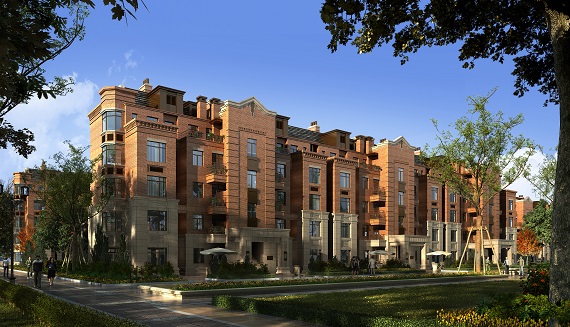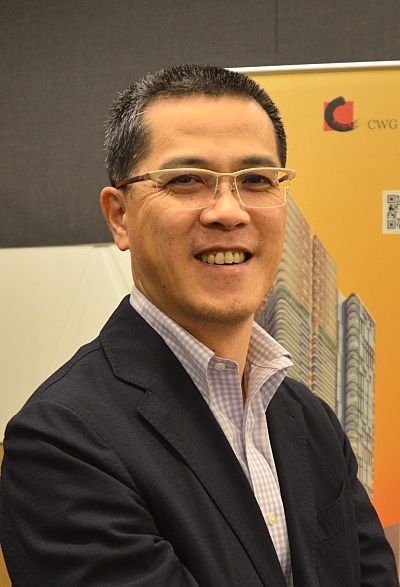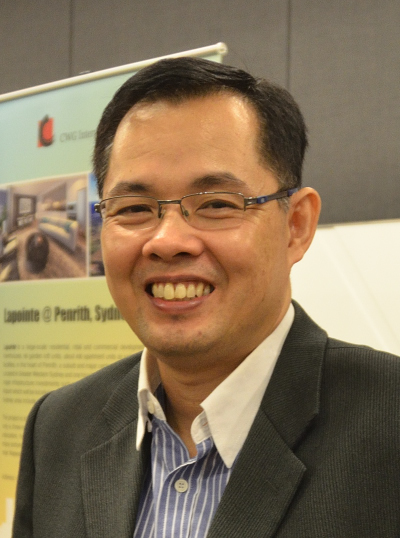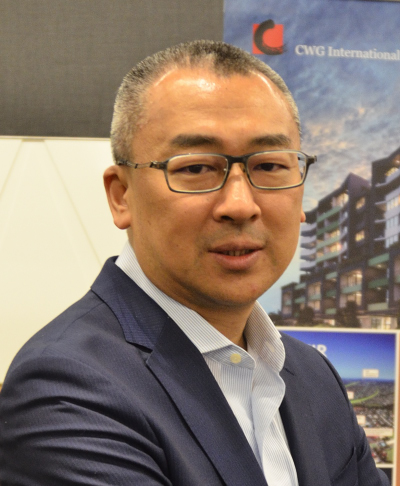 Chiway Mansion (artist's impression above) is the Group's award-winning low-density residential complex in Suzhou. Chiway Mansion (artist's impression above) is the Group's award-winning low-density residential complex in Suzhou.
CWG International (formerly Chiwayland International) announced the adoption of a dividend policy to pay shareholders 1c per share annually when it posted its 3Q2016 results.
At the recent stock price of 15.9 cents, this translates into a dividend yield of 6.3%.
In another piece of good news, its management said it expects its financial position to significantly improve with the launch of 9 new projects by the end of the year. These are: four in Suzhou, two in Xuzhou, one in Nanjing, one in Xuancheng, and one in Sydney with a combined GFA of about 400,000 sqm.
The project launches increased Group's selling and distribution expenses by 76.0% year-on-year to RMB 37.0 million, contributing to its net loss of RMB 56.6 million in 3Q2016.
Highlights for 3Q2016:
- Ongoing projects in China and Australia lifted overall unbooked sales to RMB 7.0 billion.
- Cash and cash equivalents remained healthy at RMB 1.8 billion.
- Acquired five new land parcels in Hubei and Jiangsu.
- Total debt increased to RMB 6.9 billion as at 30 September 2016 (2015: RMB 4.2 billion)
For more information, refer to its 9M2016 financial statements here.
|
At the real estate developer's 3Q2016 results briefing on Monday (7 November), Executive Chairman Qian Jianrong, Executive Director and CFO Chua Hwee Song, and Executive Director Tian Honglei provided insights into why the management is confident about its earnings outlook.
Q: How does China's property market cooling measure implemented in October affect your business?
Mr Qian: China’s property market is driven mainly by its rapid urbanization. It is currently 50% urbanized. Urbanization is expected to continue for a good 15 to 20 years before it reaches the government’s 70% target. The sector fundamentals remain strong. In the past 3 to 4 years, annual property sales were as high as 1.3 billion sqm. Even with cooling measures, the market is still growing.
|

“The health of China's property sector is reflected in the rapid growth of property giants such as China Vanke.”
- Qian Jianrong
Executive Chairman
CWG International
(Photo by Sim Kih)
|
China is as large as Europe. Cities in China with populations in tens of millions can be compared to small nations. That is why an analysis of China’s property market must factor in the huge polarization in its property market trends.
While ghost towns do exist, some PRC cities are performing so well that home prices can double in one year.
We target PRC cities with strong economic growth, strong population growth driven by immigration, and favorable housing market demand-supply inventory trends.
This data is easily accessible in China, where the standard of statistical reporting has advanced to be even more comprehensive than what we get in the U.S. and in Australia.
For each city, statistics for housing demand and supply are clear and transparent. These statistics include annual figures for sales, the number of unsold units, and land accumulated by each property developer as well as the entire market.
| Stock price |
15.9c |
| 52-week range |
4.4c-17.0c |
| Market cap |
S$110.7m |
| Debt-EBITDA |
35.4x |
| Price-Book |
0.787x |
| Dividend yield |
- |
| Source: SGX StockFacts |
The time that a property developer takes to fully sell its housing inventory is a key parameter that we track. We target cities where property developers are able to achieve 100% sales within 8 to 9 months of project launch.
This was our consideration when we decided to have projects in Suzhou, Wuxi, Nanjing, Xuzhou, and Wuhan. Tianjin and Hangzhou are next on our list.
We remain optimistic about China’s property market.
|
Q: Why is your debt so high?
Mr Chua: We expect our gearing ratio to decrease rapidly with the launch of our new projects. Our gearing was exceptionally high in 3Q2016 because we were carrying on our balance sheet large amounts for land and projects to be launched.
In China, when we acquire a parcel of land, we have to pay land acquisition costs. A relatively small portion is financed through our internal reserves and the rest through mezzanine financing and shareholder loans.
We target to commence construction within 3 to 6 months of land acquisition. If we have a project in Suzhou and want to acquire a land parcel in Wuhan, we can kick-start the Wuhan project rapidly by using the same architectural design that we used for the Suzhou project.
|

“China’s secular demand for housing is driven by its stage of urbanization. Its strong legal framework, healthy banking sector, and short capital conversion cycle for property developers make it a very attractive market for us.”
– Chua Hwee Song
Executive Director and CFO
(Photo by Sim Kih)
|
When we commence construction, we take up a developer’s loan. When the project is 20% completed, we can apply for the license to launch the project presales.
The period from our land acquisition to the presales launch is 9 to 14 months.
We will collect 100% of our sales in cash at the point of transaction. We have a number of projects that are ready for presales launch and cash collection.
This is unlike in Singapore where the property developer gets 20% of the sales value at the point of presales, and the balance is based on progression of construction.
That is why in China, the capital cycle for property development can be as short as one year, compared to 3 to 4 years in Singapore.
|
| ♦ Capital Management Strategy in China |
|
 Mr Tian: We have two joint ventures with Jiangsu Shagang, China’s leading steel mill that is also a Fortune 500 company. We hold 60% in one of the JVs (Suzhou Chiway Shangcheng Real Estate Co., Ltd), and Shagang 40%. In the other JV (Suzhou Chiway Jinhui Real Estate Co Ltd), we hold 75%, and Shagang 25%. Mr Tian: We have two joint ventures with Jiangsu Shagang, China’s leading steel mill that is also a Fortune 500 company. We hold 60% in one of the JVs (Suzhou Chiway Shangcheng Real Estate Co., Ltd), and Shagang 40%. In the other JV (Suzhou Chiway Jinhui Real Estate Co Ltd), we hold 75%, and Shagang 25%.
Recently, our scale of operations became large enough for us to activate a credit line that Shagang extended to us. We are starting out with a credit facility of RMB 2 billion, and this can increase to RMB 2.5 billion to RMB 3 billion as we expand. After we started collaborating with Shagang, we parked most of our new projects under these two JVs.
Here is how we manage the capital in these JV projects: We injected about RMB 400 million. Shagang injected an amount that is proportionate to its shareholding. Land costs about RMB 100 million to RMB 200 million and is financed from these funds and the shareholder loan that Shagang extended. We may also use mezzanine financing.
 "Every month, we have an internal cash management meeting to detail the list of outstanding liabilities and receivables due over the next 12 months. "Every month, we have an internal cash management meeting to detail the list of outstanding liabilities and receivables due over the next 12 months.
"We conduct scenario analysis using changes in sales and expenditures as parameters. We also evaluate the risk profile of our huge cash reserves, as well as our gearing and asset ratios."
- Tian Honglei
Executive Director
(Photo by Sim Kih) Together, these funds put us in a financial position that entitles us to take a developer’s loan. When we add in the funds received from presales, we are able to repay Shagang’s shareholder loan as well as the mezzanine loan. We may have other sources of funds in addition to this.
With the developer’s loan, we are able to take our time to complete our construction. This funding process gives us the leverage to finance our next project.
The rate of growth for projects parked under our JVs with Shagang is accelerating even with a relatively moderate amount of capital injection from our internal reserves. Shagang’s line of revolving credit to us reduces the burden on us when injecting capital for land.
Nowadays, the loan-to-valuation extended by banks for land acquisition is about 50% to 60%. The Group and Shagang need alternative financing solutions for the remaining 40% to 50% of the land value. With our capital management process, only a relatively moderate amount of equity capital needs to be injected for each project. The balance will be financed by the revolving line of credit that Shagang extends to us.
With China’s presales policy, we would have collected all receivables even before recognizing revenue -- that is, before residential units are delivered to home buyers. This gives us the liquidity to embark on our next project. Our cash reserves are greatly boosted as we are able to collect our receivables before we pay our suppliers. This cash movement is clearly reflected in our cash flow statement but not in our profit and loss statement.
|
 Chiway Mansion (artist's impression above) is the Group's award-winning low-density residential complex in Suzhou.
Chiway Mansion (artist's impression above) is the Group's award-winning low-density residential complex in Suzhou.



 Mr Tian: We have two joint ventures with Jiangsu Shagang, China’s leading steel mill that is also a Fortune 500 company. We hold 60% in one of the JVs (Suzhou Chiway Shangcheng Real Estate Co., Ltd), and Shagang 40%. In the other JV (Suzhou Chiway Jinhui Real Estate Co Ltd), we hold 75%, and Shagang 25%.
Mr Tian: We have two joint ventures with Jiangsu Shagang, China’s leading steel mill that is also a Fortune 500 company. We hold 60% in one of the JVs (Suzhou Chiway Shangcheng Real Estate Co., Ltd), and Shagang 40%. In the other JV (Suzhou Chiway Jinhui Real Estate Co Ltd), we hold 75%, and Shagang 25%. 





